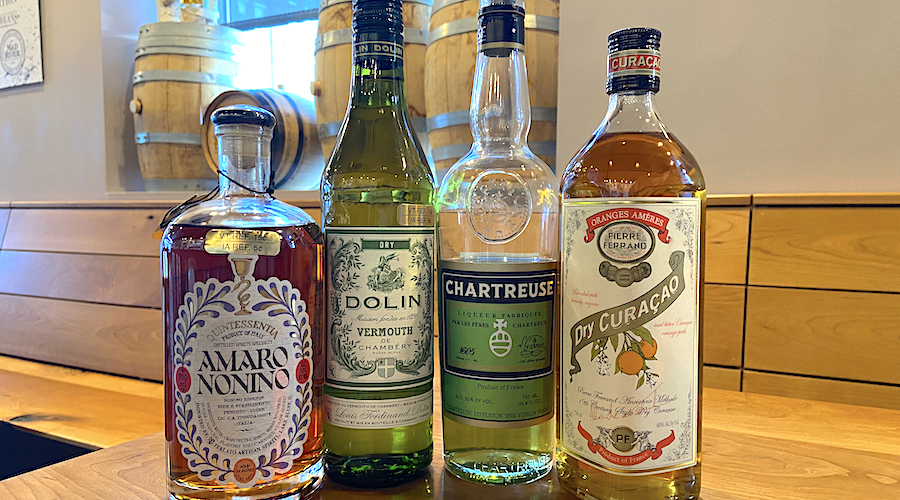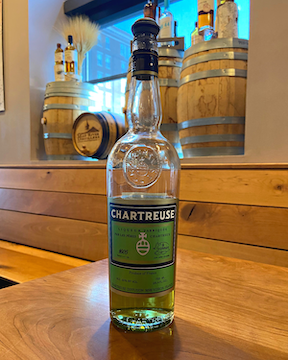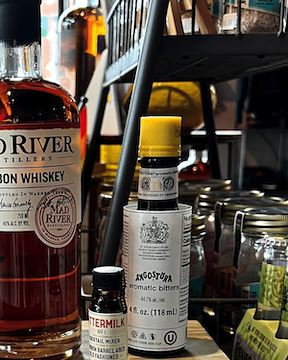Top Spirited Modifiers to Upgrade Your Cocktail Game
A “Modifier” is a term used in the mixology world to refer to an ingredient that is added to a base spirit. Modifiers give a cocktail a desired flavor or add layers of flavor to a final product. An “alcohol-based” or “spirited” modifier contains alcohol. Examples include fortified wines and liqueurs, which soften or enhance the base spirit, and add body and depth of flavor to a cocktail.
At Mad River Distillers, we often experiment with different modifiers to create delicious cocktails using our spirits, so we wanted to share the best spirit mixers that will upgrade your cocktail game when using a Mad River bourbon, rye or rum. Before we begin, a brief background on spirit modifiers may be helpful.
Pre-Prohibition cocktails are what we refer to as “Classic” cocktails, which typically used a variety of spirited modifiers. After Prohibition, a lot of modifiers became scarce as most of them were imported from Europe. The use of fruit juices, syrups, and sour mixes became the norm in cocktails, because not much else was available in the spirited modifier category. Unfortunately, this led to the overuse of prepackaged juices, sugary syrups, and powdered sugar mixes in poorly balanced, cloyingly sweet cocktails.
It wasn’t until the mid 1980’s that purists, historians, and craft cocktail bartenders started to uncover pre-prohibition cocktail recipes. Interest in the history, as well as a desire for better quality cocktails, led to an increase in demand for spirited modifiers in cocktails all over the United States. We refer to this time as the “Cocktail Renaissance or Revival.”
The category of spirited modifiers in cocktail programs has exploded in recent years. With global access to thousands of imported, classic and new age modifiers, and with the emergence of more local craft distilleries, there is an almost limitless number of new and classic cocktails you can mix up.
In this article, we’ll focus on the top modifiers—the ones we consider to be the most versatile and widely used within both “classic” and “new classic” cocktails.
VERMOUTH
Wine Enthusiast offers a great description of vermouths in their Bartender Basics: Why Is Vermouth in So Many Cocktails? article (Garret, 2020), but essentially, Vermouth is fortified, aromatized wine. Fortified means they add a strong neutral grain spirit to the wine. They are aromatized with ingredients such as herbs, spices, citrus peels, roots, and wormwood (a bittering agent) to add a complex balance of different flavors.
There are many different styles of vermouths produced. As you begin exploring new cocktails at home, you’ll notice that a large number of recipes call for one of the two most popular styles of vermouth, either sweet (red) or dry (white) vermouth.
Here are our top choices when it comes to vermouth modifiers in Mad River Distillers cocktails:
Dolin Dry
For a dry white vermouth, this is great in the Perfect Manhattan cocktail and is only slightly sweet with a bitter citrus base, bark, menthol and balsamic notes, along with almond and stone fruit fragrances (Dolin, 2019).
Carpano Antica
This sweet vermouth is used in the all-time classic stirred whiskey cocktail, the Manhattan, and in our favorite new class riff off of the Manhattan, the Greenpoint. Carpano has a vanilla taste with various notes of spice, citrus and dried fruits (Fratelli Branca Distillerie, 2017). It has a unique flavor that’s made it one of our favorite modifiers at Mad River Distillers.
Punt E Mes
Great in cocktails like the Red Hook, this sweet vermouth has an herbal aroma with a touch of bitter, and it works very well paired with sweeter base spirits, liqueurs and orange flavors (Fratelli Branca Distillerie, 2017b).
HERBAL/SPICED LIQUEURS
Herbal and spiced liqueurs are produced by distilling alcoholic extracts from a wide variety of herbs, spices or essential oils. The taste of the resulting liqueur, which can be quite unique, adds new flavors and depth to your base spirit.
Here are our top choices when it comes to herbal/spiced modifiers in Mad River Distillers cocktails:
Green Chartreuse
Otherwise known as Chartreuse Verte, this is a French liqueur made by Carthusian Monks since 1840. The recipe was passed down from an ancient herbal elixir recipe dating back to 1605. Made from 130 plants, flowers, bark, roots and spices, it is highly aromatic with a distinctive green color. The nose is herbal and peppery, and it has minty, pine and citrus flavors, with a bitter tea finish (Chartreuse, n.d.). It’s a flavorful and high proof liqueur used in some new classics like the Final Ward.
Yellow Chartreuse
Otherwise known as Chartreuse Jaune, this herbal liqueur is also made from 130 plants, flowers, bark, roots and spices. Yellow Chartreuse is a softer, lower proof version of Green Chartreuse, with a spicy nose of turmeric, citrus, anise, and floral notes. It has a distinct aroma and flavor of heather, yellow flowers and herbs, like (but paired down from) the intensity of Green Chartreuse. It’s a delicate modifier for its subtlety and softness used in a new classic cocktail, the Greenpoint (Chartreuse, n.d.-b).
Benedictine
This popular liqueur is made from a proprietary blend of 27 plants and spices. It is herbal and spicy on the nose, with the flavors of citrus, light honey, warm spices and almonds (Dom Liqueur, n.d.). Benedictine is a great modifier for cocktails like La Lousiane and the Vieux Carre.
Absinthe
Made by many different producers now, Absinthe originated in Switzerland, and has, up until recent years, been banned in most Western countries. This herbal liqueur has a distinct black licorice flavor, resulting from one of its primary ingredients—wormwood—along with anise and fennel. For some, it’s an acquired taste, but we think it is essential for cocktails like La Louisiane and the famous Sazerac as a modifier that plays a balancing act with sweet liqueurs and other cocktail ingredients. It is also very popular in Tiki style cocktails, too. A little goes a long way!
AMARO
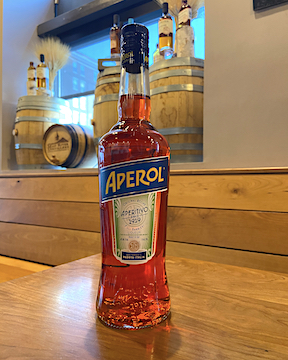
Bittersweet in flavor, infused, and aromatized, Amaro liqueur typically has a brandy base. Originating in Italy, Amari (plural for Amaro) were traditionally made by families who produced wine, using the leftovers from the winemaking process to make their Amaro base of Grappa (Italian brandy). They were historically consumed to wake up the palate, aid in digestion, or simply as an afternoon “pick me up.” Like the herbal and spiced liqueurs above, Amari have flavors of herbs, spices and botanicals. However, they are usually sweetened with beet sugar and aged, and they also tend to have strong bitter components from the different barks and roots used to flavor it (such as Gentian, Quinine, and wormwood). With many different styles and brands of Amaro, the flavor of each one can vary greatly. Check out this article by Difford’s Guide (n.d.), which provides a great overview on the category.
Here are Mad River’s top recommendations for Amaro modifiers in cocktails:
Aperol
Known as an aperitif, meaning it is an alcoholic drink intended to stimulate your appetite, Aperol has a distinct bright orange and pinkish color and a bittersweet taste derived from the proprietary blend of oranges, herbs and roots (APEROL, 2021). The sweet flavors of vanilla and orange, blended with tart and bitter rhubarb and grapefruit notes, make it perfect in cocktails like the Paper Plane.
Campari
Another aperitif, Campari offers a similar appearance to Aperol, but with a darker red hue. The distinct flavor is the result of the bitters, herbs, aromatic plants, and fruit used to infuse the liqueur, the exact specifications of which are a tightly kept secret. The bitter orange taste of Campari makes it excellent in cocktails like a Kingston Negroni or Boulevardier (all riffs of the Negroni cocktail).
Amaro Nonino
Made with a proprietary blend of herbs in Northern Italy, Amaro Nonino offers a delicate balance of sweet and bitter. With the scent of orange and the taste of pepper, licorice, and cocoa (Amaro Nonino, 2022), it makes a great addition to a Paper Plane cocktail, and it is a deeper, bitter substitute for Campari or sweet vermouth in cocktail variations like the Black Manhattan (swapping a dark Amaro for a sweet vermouth). For an alternative that may be easier to find than Amaro Nonino, try Amaro Montenegro, another one of our favorites.
BITTERS
Similar to the elongated version, Amaro, Bitters are only used in small quantities such as a “dash” or “drop” in a cocktail. They are flavored with sharp, pungent flavors, usually very dry and bitter in flavor, and were historically used as a medicine to help aid digestion or to promote appetite. They are the “dash of seasoning” in many cocktails—most famously, the Old Fashioned cocktail, which ties together the flavors of a strong spirit like whiskey and sweet sugar.
Here are Mad River’s top recommendations for bitters to add to your cocktails:
Angostura Bitters
A popular addition to cocktails, these bitters are a staple item for any home bar. With a taste of herbs, fruits and spices that enhance the flavor of your cocktail, just a couple dashes of Angostura bitters work like a digestif to help settle the stomach while imbibing (ANGOSTURA® aromatic bitters, 2018).
Peychaud’s Bitters
These bitters are a must-have for making a Sazerac (the cocktail named after Sazerac Whiskey, which was used in the original recipe). The zesty grapefruit and anise flavor of Peychaud’s is created from distilled spirits infused with botanicals (Sazerac, n.d.). You’ll also use these bitters in other classics like the La Louisiane cocktails.
Regans Orange Bitters
Made with a base of alcohol, bitter orange extract and various herbs, Regans is a famous herbal orange bitter that was developed by Gary Regan, a cocktail authority well-known in the U.S.. It’s one of the more bitter of the orange bitters options, and it works quite well in a Greenpoint cocktail. There are many different styles and brands of orange bitters, and all are unique in their own way. Trying different brands is a fun way to experiment with new flavors!
FRUIT & INFUSED LIQUEURS
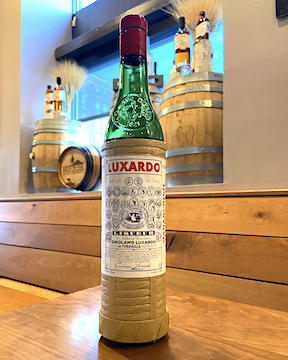
Mixing up a great cocktail involves a balance of flavors. Too bitter or too sweet, and the cocktail flavor will be hard to enjoy. Fruit and infused liqueurs are great at softening or enhancing your base spirit. Made from alcohol, fruit and added sugars, there are a wide variety of these typically sweet liqueurs to choose from.
Here are two fruit / infused liqueurs that Mad River Distillers recommends using as a modifier for cocktails:
Luxardo Maraschino
This is a clear liqueur made from marasca cherries. While it smells like marasca cherry with a roasted nuttiness, the flavor has hints of chocolate, vanilla and orange marmalade (Luxardo, 2021). Luxardo Maraschino is a great modifier that made two popular cocktail variations famous—the Hemingway Daiquiri and the Red Hook cocktail
Pierre Ferrand Dry Curacao
The recipe for this classic, sweet orange liqueur is considered a traditional French triple sec. Distilled from spices and peels of Curacao oranges, which are blended with brandy and Ferrand Cognac, this liqueur smells like candied orange and tastes of orange rind, vanilla and oak (Maison Ferrand, n.d.). It is a popular modifier in cocktails such as the Mai Tai and Margarita!
If you’re just starting to build your home bar, purchase one bottle recommendation within each of these basic modifier categories—Vermouth, Herbal/Spiced Liqueurs, Amaro, Bitters and Fruit & Infused Liqueurs. These recommendations will absolutely upgrade your cocktail game!
Stay tuned for our next article, which will include recipes for new and classic cocktails you can make using modifiers.
Written by Maeghan Phillips and Brianne Lucas. Published on January 17, 2022
REFERENCES
Garret, D. (2020, October 30). Bartender Basics: Why Is Vermouth in So Many Cocktails? Wine Enthusiast. Retrieved January 13, 2022, from https://www.winemag.com/2020/10/30/best-vermouth-cocktails-bartender/
Dolin. (2019, October 30). Discover the Vermouth Dry for your cocktails & drinks. Retrieved January 13, 2022, from https://www.dolin.fr/en/products/vermouth-dry/
Fratelli Branca Distillerie. (2017, February 10). Antica Formula: THE ONLY ANTIQUE JEWEL “ON THE ROCKS” | Carpano.com. Carpano. Retrieved January 13, 2022, from https://www.carpano.com/en/prodotto/antica-formula-2/?age-verified=78279094e3
Fratelli Branca Distillerie. (2017b, February 16). Punt e Mes: ONE POINT OF SWEETNESS AND HALF A POINT OF BITTERNESS. Carpano. Retrieved January 13, 2022, from https://www.carpano.com/en/prodotto/punt-e-mes-2/
Chartreuse. (n.d.). Green Chartreuse. Chartreuse Diffusion. Retrieved January 13, 2022, from https://www.chartreuse.fr/en/produit/green-chartreuse/
Chartreuse. (n.d.-b). Yellow Chartreuse. Chartreuse Diffusion. Retrieved January 13, 2022, from https://www.chartreuse.fr/en/produit/yellow-chartreuse/
Dom Liqueur. (n.d.). Dom Liqueur | Dom 1510 Liqueur. Benedictine. Retrieved January 13, 2022, from https://www.benedictinedom.com/our-liqueurs/benedictine-dom-liqueur/
Difford’s Guide. (n.d.). Amari. Retrieved January 13, 2022, from https://www.diffordsguide.com/beer-wine-spirits/category/1202/amari
A. (2021, July 23). Meet. Aperol. Retrieved January 13, 2022, from https://www.aperol.com/meet-aperol/
Amaro Nonino. (2022, January 10). Amaro Nonino Quintessentia®- the all natural Italian Amaro. Grappa Nonino. Retrieved January 13, 2022, from https://www.grappanonino.it/en/amaro-and-liqueurs/amaro-nonino-quintessentia/
Montenegro, A. (n.d.). The Revelation. Unearthing Pure Essence. Amaro Montenegro. Retrieved January 13, 2022, from https://www.amaromontenegro.com/en?nolangred=1#SecretRecipe
ANGOSTURA® aromatic bitters. (2018, March 21). Home. Angostura. Retrieved January 13, 2022, from https://angosturabitters.com
Sazerac. (n.d.). Peychaud’s. Retrieved January 13, 2022, from https://www.sazerac.com/our-brands/sazerac-brands/peychauds.html
Luxardo. (2021, May 12). Maraschino Originale. Retrieved January 13, 2022, from https://www.luxardo.it/liqueurs-and-distillates/maraschino-originale/
Maison Ferrand. (n.d.). Maison Ferrand | Ferrand Dry Curaçao. Retrieved January 13, 2022, from http://maisonferrand.com/en/content/pf-dry-curacao-1/



